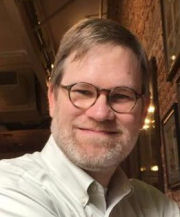
The following is a guest post by James Miller, whose poetry appeared in issue 20 of Typehouse.
_______________________________________
We have a long global tradition of writing about visual art—ekphrasis. Anne Sexton’s “The Starry Night” is an important one for me, a poem that captures her longing to dive into Van Gogh’s raw brushstrokes. Sexton seeks a more vivid and dangerous world, one ruled by a “great dragon” that demands absolute commitment to fearless creation.
Many ekphrastic writers follow a similar path. They begin in a self-conscious posture of looking, often at a framed masterpiece on the gallery wall. Their lines seek to animate static images with floods of association, reflection, desire. But poets have also responded to films, theater, and music—all of which unfold across charged minutes. These are arts of entrance, sojourn and exit; to write about them, we explore the subjective experience of duration.
I thought about these ideas when I first saw Gerhard Richter Painting (2011), by German documentarian Corinna Belz. Her film privileges the artist in the studio, working. Mostly we stand behind Richter, waiting with him as he considers… reconsiders… doubts. And acts. He covers a massive canvas with broad swathes of black, yellow, red. Then he steps back, into stillness. Then he lifts a monster squeegee from the table, approaches his abstract slab of paint…and smears color from left to right, or ceiling to floor.
I gasped audibly the first time the squeegee came out. The first time the paint blurred and failed, dropped away to reveal layers of hidden texture, half-memories of a half-hour before, an hour, a day, a week. Part of what excited me about Richter’s method was the slow and steady pace of his movements. He seemed to lean into motion as if shifting a great weight, taking his time. This was far from the flippant wipe we sometimes see between scenes in an old action movie, or the unthinking everyday swipe so characteristic of social media… thank you, next! Richter’s patience was touched by a menacing quality: Let us see what is hidden, he seemed to say. And in so doing, let us distort and blur and misremember and forget. We do all of this willingly, with courage.
What did this film teach me about seeing? In my poem “Gerhard Richter Painting,” I tried to describe his decisive gesture, bringing forms into being while simultaneously defacing or obscuring them. As Richter worked, I thought of warehouses on the shores of memory, filled with piercing remnants of a life, or a culture, or an ecology. The artist can open the warehouse door, revealing an impossibly rich and suggestive jumble. But the artist must also close that door, perhaps wincing at the squeal of metal as it comes down, bringing darkness again to once cherished things.
_______________________________________
James Miller is a native of the Texas Gulf coast. He won the Connecticut Poet Award in 2020, and his poems have appeared or are forthcoming in Cold Mountain Review, The Maine Review, Lunch Ticket, The Atlanta Review, Thin Air, A Minor, Eclectica, Rabid Oak, pioneertown, Juked, North Dakota Quarterly, Yemassee, Phoebe, Mantis and elsewhere.